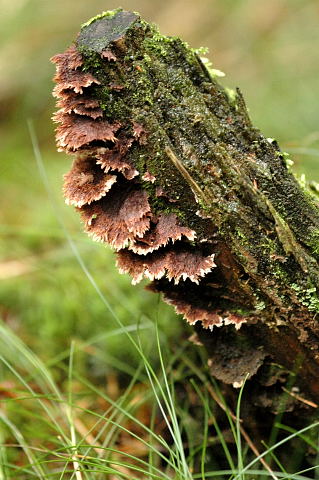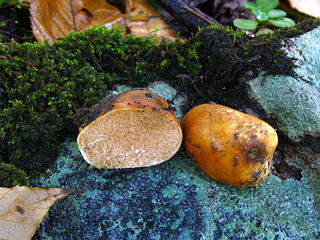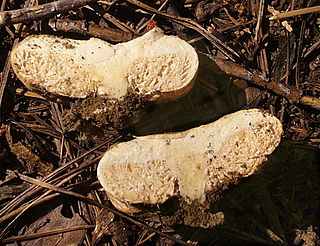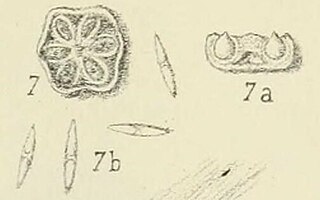Scortechinia is a genus of fungi in the Ascomycota, of the family Nitschkiaceae.
Spegazzinia is a genus of widely distributed mitosporic ascomycete fungi in the family Didymosphaeriaceae.As accepted by Wijayawardene et al. 2020.

Auguste François Marie Glaziou was a French landscape designer and botanist born in Lannion, Brittany.
Trabutia is a genus of fungi in the family Phyllachoraceae.
Bertiella is a genus of fungi in the family Teichosporaceae. although Wijayawardene et al. 2020 places it within the Melanommataceae family.
Hjortstamia is a genus of corticioid fungi in the family Phanerochaetaceae. It was circumscribed by French mycologists Jacques Boidin and Gérard Gilles in 2003.

Cystolepiota is a genus of mushroom-forming fungi in the family Agaricaceae.

Rimbachia is a genus of fungi in the family Tricholomataceae. The genus contains about ten species with a widespread distribution in tropical regions.
Skepperiella is a genus of fungus in the family Marasmiaceae. The widespread genus contains four species. The genus was circumscribed by Albert Pilát in Bull. Soc. Mycol. France vol.43 on page 56 in 1927.
Skepperia is a genus of fungi in the family Thelephoraceae. The genus was described by mycologist Miles Joseph Berkeley in 1857 to contain the type species Skepperia convoluta. The genus was circumscribed by Berkeley in Trans. Linn. Soc. London vol.22 on page 130 in 1857.

Thelephora is a genus of fungi in the family Thelephoraceae. The genus has a widespread distribution and contains about 50 species. Fruit bodies of species are leathery, usually brownish at maturity, and range in shape from coral-like tufts to having distinct caps. Almost all species in the genus are thought to be inedible, but Thelephora ganbajun is a gourmet fungus in Yunnan province of southwest China.

Zelleromyces is a genus of fungi in the family Russulaceae. It was first described by mycologists Rolf Singer and Alexander H. Smith in 1960 to contain hypogeous (underground) fungi with gasteroid fruit bodies that "bleed" latex when they are cut.

Job Bicknell Ellis was a pioneering North American mycologist known for his study of ascomycetes, especially the grouping of fungi called the Pyrenomycetes. Born and raised in New York, he worked as a teacher and farmer before developing an interest in mycology. He collected specimens extensively, and together with his wife, prepared 200,000 sets of dried fungal samples that were sent out to subscribers in series between 1878 and 1894. Together with colleagues William A. Kellerman and Benjamin Matlack Everhart, he founded the Journal of Mycology in 1885, forerunner to the modern journal Mycologia. He described over 4000 species of fungi, and his collection of over 100,000 specimens is currently housed at the herbarium of the New York Botanical Gardens. Ellis had over 100 taxa of fungi named in his honor.
Glaziellaceae is a family of fungi in the order Pezizales that contains the single monotypic genus Glaziella. The type species Glaziella vesiculosa, originally collected in Cuba, was referred to the genus Xylaria by Miles Joseph Berkeley and Moses Ashley Curtis in 1869. A decade later, Berkeley circumscribed the genus Glaziella to contain a specimen collected in Brazil, apparently forgetting that he had earlier named it Xylaria aurantiaca.
Pluteus aethalus is a species of agaric fungus in the family Pluteaceae. It is found in Cuba. The species was originally named Agaricus aethalus by Miles Joseph Berkeley & Moses Ashley Curtis in 1869, and later transferred to the genus Pluteus by Pier Andrea Saccardo in 1887. It is classified in Pluteus section Celluloderma, subsection Mixtini.

Peyronellaea is a genus of fungi in the family Didymellaceae. It contains a number of plant pathogens.

Arcangeliella is a genus of gasteroid fungi in the family Russulaceae. Taxonomic and phylogenetic research has shown that it is very likely a synonym of Lactarius. The type species Arcangeliella borziana was moved to Lactarius in 2003. However, the genus name is still in use for several species for which new combinations have not yet been proposed.

Aschersonia is a genus of fungi in the order Hypocreales and family Clavicipitaceae.
Harzia is a genus of seed-borne fungus that occurs in the soil. It has been categorized in the Ceratostomataceae family. The genus Harzia originally contained three accepted species: Harzia acremonioides, Harzia verrucose, and Harzia velatea. Within the genus Harzia, Harzia acremonioides is one of the most common species that can be found in all climate regions around the world.









